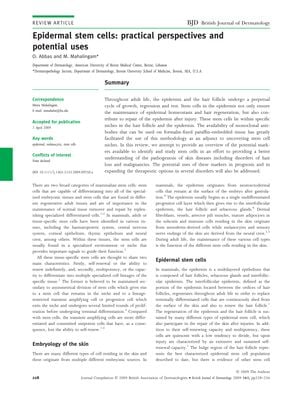Epidermal Stem Cells: Practical Perspectives and Potential Uses
April 2009
in “
British Journal of Dermatology
”
epidermal stem cells CK19 p63 CD34 CD200 Tenascin-C Lhx2 MTS24 Bmi-1 hair pigmentation scarring alopecias cutaneous malignancies cancer stem cells bioengineered hair follicles alopecia regenerative medicine gene therapy stem cells hair loss skin cancer hair follicles scarring hair loss hair regeneration hair loss treatment

TLDR Epidermal stem cells could lead to new treatments for skin and hair disorders.
The 2009 document reviews the characteristics, identification, and potential therapeutic applications of epidermal stem cells, particularly in relation to skin and hair disorders. It emphasizes the importance of stem cell markers like CK19, p63, CD34, CD200, Tenascin-C, Lhx2, MTS24, Bmi-1, and others in distinguishing various stem cell populations within the skin, including those responsible for hair pigmentation and immune response. The review also discusses the role of these cells in the pathogenesis of diseases such as scarring alopecias and cutaneous malignancies, suggesting that cancer stem cells may arise from mutated normal stem cells. It explores the potential of stem cells in regenerative medicine, including the generation of bioengineered hair follicles for alopecia treatment, nerve regeneration, and gene therapy for congenital disorders. The document concludes that while the search for definitive stem cell markers continues, the current markers are essential for progressing dermatological research and developing new treatments.






